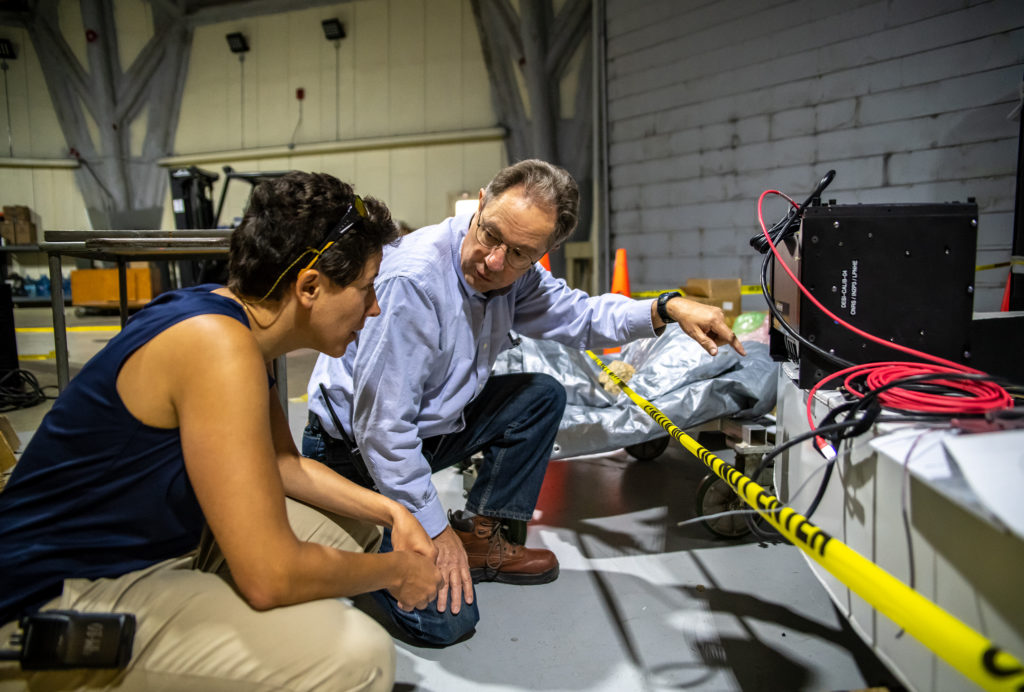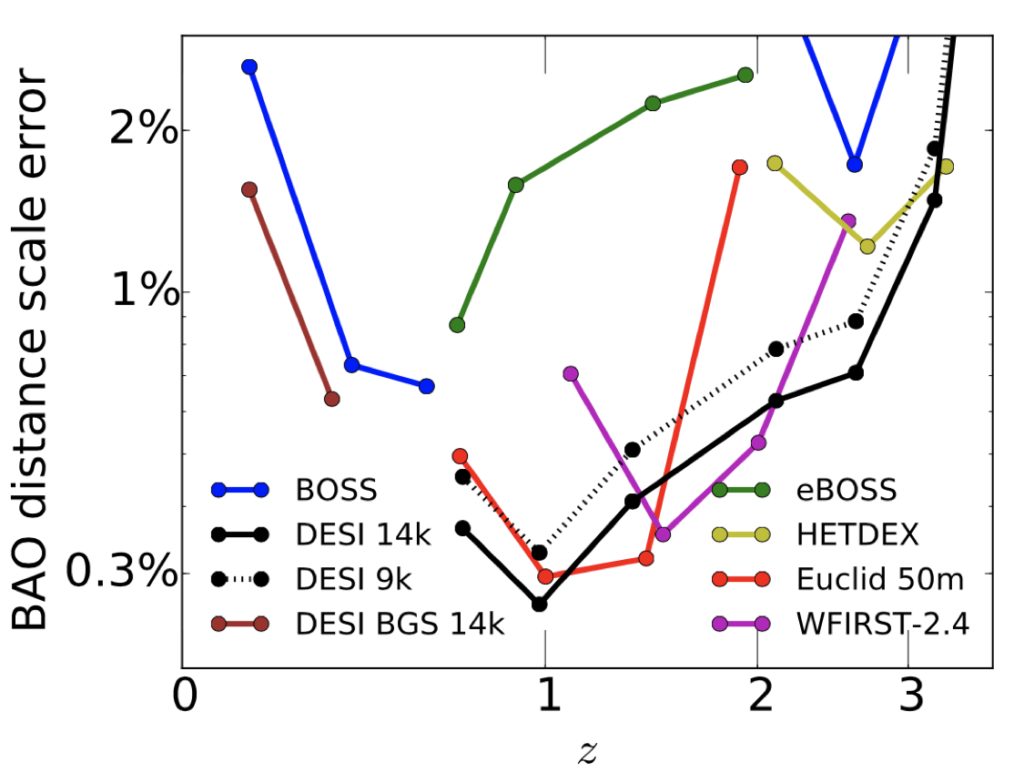
The primary cosmology mission of DESI is to study the nature of dark energy: How does its energy density evolve in time, and how does it affect the clustering of matter? To do this, DESI will use its maps to measure two cosmological effects: baryon acoustic oscillations and redshift-space distortions. The same maps will also provide other opportunities to study cosmology and the physics of galaxies, quasars, and intergalactic gas.
Baryon Acoustic Oscillations
DESI is optimized to measure a subtle imprint in the maps that is all that remains of an important physical process in the early universe known as the baryon acoustic oscillations (BAO). To explain this effect, we must first account for the cosmic microwave background radiation—the heat left over from the Big Bang—that fills the universe. Today the temperature is only 2.7  degrees above absolute zero, but at earlier times it was much hotter. Prior to 400,000 years after the Big Bang, when the universe was over a billion times denser than it is today, the background radiation was hot enough to cause the hydrogen and helium to be ionized, separating the electrons from atomic nuclei and forming a plasma. The electrons scattered easily with the photons of the background and the photons provided a very strong radiation pressure that resisted compression of the gas. Density perturbations created in the first fraction of a second of the universe thereby traveled as sound waves, or baryon acoustic oscillations, in this plasma. The sound waves traveled through the universe for 400,000 years, coming to a halt when the expanding universe cooled enough that the electrons and nuclei combined into neutral atoms. At this point, the gravitational forces of the density perturbations dominated and started to shape the universe into the large-scale structure that we see today. But the effect of the sound waves can still be measured: Around each overdense region there is a faint spherical imprint of the wave that left that region. This has created a slight tendency for pairs of galaxies to be separated by the distance the waves traveled, which owing to the expanding Universe is about 500 million light-years today. This faint relic imprint has been observed in several data sets, most notably from the Sloan Digital Sky Survey (SDSS) and its Baryon Oscillation Spectroscopic Survey (BOSS).This subtle correlation is now a major player in the study of dark energy.
degrees above absolute zero, but at earlier times it was much hotter. Prior to 400,000 years after the Big Bang, when the universe was over a billion times denser than it is today, the background radiation was hot enough to cause the hydrogen and helium to be ionized, separating the electrons from atomic nuclei and forming a plasma. The electrons scattered easily with the photons of the background and the photons provided a very strong radiation pressure that resisted compression of the gas. Density perturbations created in the first fraction of a second of the universe thereby traveled as sound waves, or baryon acoustic oscillations, in this plasma. The sound waves traveled through the universe for 400,000 years, coming to a halt when the expanding universe cooled enough that the electrons and nuclei combined into neutral atoms. At this point, the gravitational forces of the density perturbations dominated and started to shape the universe into the large-scale structure that we see today. But the effect of the sound waves can still be measured: Around each overdense region there is a faint spherical imprint of the wave that left that region. This has created a slight tendency for pairs of galaxies to be separated by the distance the waves traveled, which owing to the expanding Universe is about 500 million light-years today. This faint relic imprint has been observed in several data sets, most notably from the Sloan Digital Sky Survey (SDSS) and its Baryon Oscillation Spectroscopic Survey (BOSS).This subtle correlation is now a major player in the study of dark energy.
When we observe a sample of galaxies at high redshift and detect their distinctive clustering scale, we know that the scale is 500 million light-years. With that, we can infer the distance to the galaxies. It is as if the redshift survey has given us a map without an obvious conversion of inches to miles—by careful analysis on the spacing of the galaxies we can infer the correct scaling factor. DESI will use the BAO to measure the relationship of distance to redshift over a wide range of redshifts with subpercent precision. This in turn allows us to infer the expansion history and the evolution of dark energy.
Redshift-space distortions
When DESI measures the redshift of galaxies, this measurement is actually composed of two contributions: the large shift coming from the cosmological expansion of the universe, and a smaller shift that results from the motion of the galaxy due to the gravitational pull from the universe’s surrounding large-scale structure. The latter is known as the peculiar velocity. By measuring the size of the peculiar velocity, scientists can measure the amount of mass in the large-scale structure.
Or if that is known from other methods, we can test whether gravitational attractions on scales of hundreds of millions of light-years follows the predictions of Albert Einstein’s theory of general relativity, which relates to gravity. The testing of general relativity on these enormous scales is important as it might reveal alternative explanations, known as modified gravity theories, for the universe’s accelerating expansion rate. On the very largest scales we find that the expansion rate is evolving very differently from what would be predicted from the attractions of known matter and the physics that are so well-tested on solar system scales. Perhaps this breakdown has other signatures in the universe’s large-scale structure.
The size of the velocities can be measured in the DESI maps by comparing the characteristic amplitudes of the large-scale clustering of galaxies in directions perpendicular to the line of sight to the clustering signals in directions along the line of sight. This is known as redshift-space distortions. Because the large-scale structure we are measuring is giving rise to the peculiar velocities, there is a systematic change in the appearance of the large-scale structure. Careful analysis of the DESI maps can reveal this signature to high precision.
DESI in the Dark Energy Portfolio
The enigma of dark energy and the ongoing appeal of cosmology continues to motivate a wide range of cosmological experiments. DESI is one of the most ambitious surveys now under development, and once operational it will quickly become the world’s largest galaxy redshift survey. The exquisite 3D maps from DESI will have great opportunity on their own, but they become even more effective when combined with data from upcoming imaging surveys in optical/infrared, microwave, and X-ray light. One of the hallmarks of modern cosmology is the ability to measure cosmological properties in multiple manners, as the comparison of results can reinforce confidence in the answers and can point the way to new opportunities. We look forward to the prominent and collaborative role that DESI will play in the cosmological portfolio of the next decade, particularly in the study of dark energy.
Beyond Dark Energy
The DESI maps will be used for many other applications beyond baryon acoustic oscillations and redshift-space distortions. We expect that our measurements of the intermediate-redshift amplitude of large-scale structure will be important to measurements of the mass of the neutrino. Our measurements on the largest scales can test whether the initial perturbations in the universe follow the simplest model, or alternatively show correlations indicative of novel behaviors at the enormous energy scales of the first second of the universe. Detailed measurements of galaxy clustering can use gravitational clustering to test a wide range of extensions to the standard cosmological model. Beyond cosmology, DESI will measure precise distances to millions of galaxies and quasars whose properties and demographics can then be better interpreted. DESI will produce the most detailed map yet of the nearby universe, which will provide the backbone for studies of galaxy groups and clusters as well as of extreme phenomena within those galaxies. And DESI’s stellar spectroscopy will measure the dynamical state of the Milky Way halo and thick disk in great detail.







